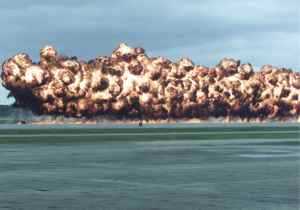Articles >>
Napalm
Category: Term of the day

Napalm is any of a number of flammable liquids used in warfare, often jellied gasoline. Napalm is actually the thickener in such liquids, which when mixed with gasoline makes a sticky incendiary gel. Modern napalm is composed primarily of benzene and polystyrene, and is known as napalm-B.
Napalm was used in flamethrowers and bombs by the U.S. and Allied forces, to increase effectiveness of flammable liquids. The substance is formulated to burn at a specific rate and adhere to materials. Napalm is mixed with gasoline in various proportions to achieve this. Another useful (and dangerous) effect, primarily involving its use in bombs, was that napalm "rapidly deoxygenates the available air" as well as creating large amounts of carbon monoxide causing suffocation. Napalm bombs were also used in the Vietnam War to clear landing zones for helicopters.
Napalm is usually a mixture of gasoline with suitable thickening agents. The earliest thickeners were soaps, aluminum, and magnesium palmitates and stearates. Depending on the amount of added thickener, the resulting viscosity may range between syrupy liquid and thick rubbery gel. The content of long hydrocarbon chains makes the material highly hydrophobic (resistant to wetting with water), making it more difficult to extinguish. Thickened fuel also rebounds better from surfaces, making it more useful for operations in urban terrain.
There are two types of napalm: oil-based with aluminum soap thickener, and oil-based with polymeric thickener ("napalm-B").
Napalm reaches burning temperatures of approximately 1,200 °C (2,200 °F). Other additives can be added, eg. powdered aluminum or magnesium, or white phosphorus. |
Discuss
